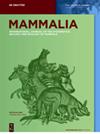Using photo by-catch data to reliably estimate spotted hyaena densities over time
IF 0.8
4区 生物学
Q3 ZOOLOGY
引用次数: 0
Abstract
Protected areas are becoming increasingly isolated refugia for large carnivores but remain critical for their survival. Spotted hyaenas (利用副渔获物照片数据可靠地估算斑鬣狗的长期密度
保护区正日益成为大型食肉动物与世隔绝的栖息地,但对它们的生存仍然至关重要。斑头鬣狗(Crocuta crocuta)是非洲大型食肉动物协会的重要成员,但与该协会的其他成员一样,经常与人类发生冲突,因为它们的家园范围很大,并不总是局限在保护区内。为了有效地保护斑头鬣狗的种群,最重要的是通过可靠和经济有效的技术来监测它们的数量。2013 年至 2018 年期间,我们利用相机陷阱图像和空间明确捕获-再捕获(SECR)框架估算了南非 Hluhluwe-iMfolozi 公园(HiP)的斑鬣狗密度。我们估计,2013 年至 2018 年期间,平均每 100 平方公里有 18.29 ± 3.27 只斑纹鬣狗,2014 年估计最高为每 100 平方公里 20.83 只,2015 年最低为每 100 平方公里 11.98 只。我们的研究结果表明,相机捕捉器的副捕获物数据可用于估算斑头鬣羚在一段时间内的密度。我们认为,鉴于相机陷阱在整个非洲的广泛使用和部署,利用现有数据改进区域和非洲大陆对斑鬣狗的估计和种群趋势的合作努力应该是一个优先事项。
本文章由计算机程序翻译,如有差异,请以英文原文为准。
求助全文
约1分钟内获得全文
求助全文
来源期刊

Mammalia
生物-动物学
CiteScore
2.20
自引率
10.00%
发文量
68
审稿时长
6-12 weeks
期刊介绍:
Mammalia is an international, multidisciplinary, bimonthly journal devoted to the inventory, analysis and interpretation of mammalian diversity. It publishes original results on all aspects of the systematics and biology of mammals with a strong focus on ecology, including biodiversity analyses, distribution habitats, diet, predator-prey relationships, competition, community analyses and conservation of mammals. The journal also accepts submissions on sub-fossil or recently extinct mammals.
 求助内容:
求助内容: 应助结果提醒方式:
应助结果提醒方式:


